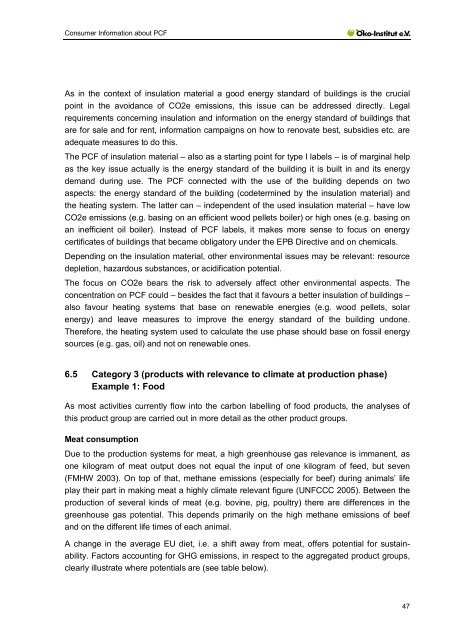Requirements on Consumer Information about Product ... - ANEC
Requirements on Consumer Information about Product ... - ANEC
Requirements on Consumer Information about Product ... - ANEC
You also want an ePaper? Increase the reach of your titles
YUMPU automatically turns print PDFs into web optimized ePapers that Google loves.
C<strong>on</strong>sumer Informati<strong>on</strong> <strong>about</strong> PCF<br />
As in the c<strong>on</strong>text of insulati<strong>on</strong> material a good energy standard of buildings is the crucial<br />
point in the avoidance of CO2e emissi<strong>on</strong>s, this issue can be addressed directly. Legal<br />
requirements c<strong>on</strong>cerning insulati<strong>on</strong> and informati<strong>on</strong> <strong>on</strong> the energy standard of buildings that<br />
are for sale and for rent, informati<strong>on</strong> campaigns <strong>on</strong> how to renovate best, subsidies etc. are<br />
adequate measures to do this.<br />
The PCF of insulati<strong>on</strong> material – also as a starting point for type I labels – is of marginal help<br />
as the key issue actually is the energy standard of the building it is built in and its energy<br />
demand during use. The PCF c<strong>on</strong>nected with the use of the building depends <strong>on</strong> two<br />
aspects: the energy standard of the building (codetermined by the insulati<strong>on</strong> material) and<br />
the heating system. The latter can – independent of the used insulati<strong>on</strong> material – have low<br />
CO2e emissi<strong>on</strong>s (e.g. basing <strong>on</strong> an efficient wood pellets boiler) or high <strong>on</strong>es (e.g. basing <strong>on</strong><br />
an inefficient oil boiler). Instead of PCF labels, it makes more sense to focus <strong>on</strong> energy<br />
certificates of buildings that became obligatory under the EPB Directive and <strong>on</strong> chemicals.<br />
Depending <strong>on</strong> the insulati<strong>on</strong> material, other envir<strong>on</strong>mental issues may be relevant: resource<br />
depleti<strong>on</strong>, hazardous substances, or acidificati<strong>on</strong> potential.<br />
The focus <strong>on</strong> CO2e bears the risk to adversely affect other envir<strong>on</strong>mental aspects. The<br />
c<strong>on</strong>centrati<strong>on</strong> <strong>on</strong> PCF could – besides the fact that it favours a better insulati<strong>on</strong> of buildings –<br />
also favour heating systems that base <strong>on</strong> renewable energies (e.g. wood pellets, solar<br />
energy) and leave measures to improve the energy standard of the building und<strong>on</strong>e.<br />
Therefore, the heating system used to calculate the use phase should base <strong>on</strong> fossil energy<br />
sources (e.g. gas, oil) and not <strong>on</strong> renewable <strong>on</strong>es.<br />
6.5 Category 3 (products with relevance to climate at producti<strong>on</strong> phase)<br />
Example 1: Food<br />
As most activities currently flow into the carb<strong>on</strong> labelling of food products, the analyses of<br />
this product group are carried out in more detail as the other product groups.<br />
Meat c<strong>on</strong>sumpti<strong>on</strong><br />
Due to the producti<strong>on</strong> systems for meat, a high greenhouse gas relevance is immanent, as<br />
<strong>on</strong>e kilogram of meat output does not equal the input of <strong>on</strong>e kilogram of feed, but seven<br />
(FMHW 2003). On top of that, methane emissi<strong>on</strong>s (especially for beef) during animals’ life<br />
play their part in making meat a highly climate relevant figure (UNFCCC 2005). Between the<br />
producti<strong>on</strong> of several kinds of meat (e.g. bovine, pig, poultry) there are differences in the<br />
greenhouse gas potential. This depends primarily <strong>on</strong> the high methane emissi<strong>on</strong>s of beef<br />
and <strong>on</strong> the different life times of each animal.<br />
A change in the average EU diet, i.e. a shift away from meat, offers potential for sustainability.<br />
Factors accounting for GHG emissi<strong>on</strong>s, in respect to the aggregated product groups,<br />
clearly illustrate where potentials are (see table below).<br />
47
















